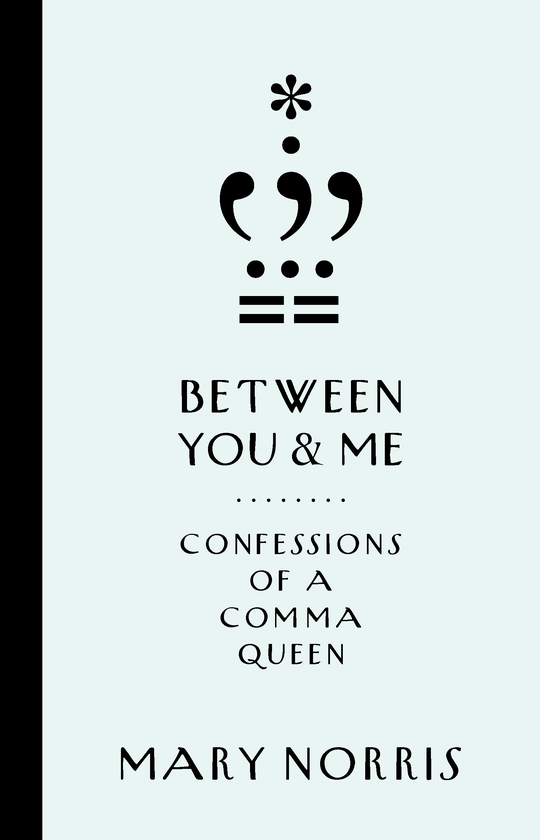 BETWEEN YOU AND ME: CONFESSIONS OF A COMMA QUEEN
BETWEEN YOU AND ME: CONFESSIONS OF A COMMA QUEEN
Text Publishing
April 2015
Between you and me, Between You and Me* may well have made it into my top three favourite not dull books on Modern English grammar and punctuation. Now, I’m not saying the Commonwealth of Australia’s Style Manual is dull but it’s not exactly a rollercoaster made of glitter. Between You and Me is not a style manual but Mary Norris’s autobiographical account of life as a copy editor at The New Yorker. Though the reasons for loving it are numerous, it deserves accolades for making me aware of the existence of a pencil sharpener museum and that a pencil party is a thing that can happen.
Before reading this, Mary Norris’s first book, I had a vague notion that someone called the Comma Queen existed†. Of course, being so far removed from any stimulus that might encourage reading of The New Yorker, I have managed to remain unfamiliar with her work. Thus my only attraction to the book was its contents, which promised fabulous giblets of juicy punctuation fun. I have since discovered the Comma Queen has begun a wonderful video series, on The New Yorker’s website, which I will be following from now on.
I love punctuation, I do. Commas especially have a special place in my affections, though I do feel I overuse them. Of late I have become smitten with the em rule. It has become my main ally in the battle to not look like a mad comma propagandist. I’m certain Mary Norris would not be overly impressed with my liberal and more than likely erroneous use of this caudated little punctus. In fact I’m almost terrified by the thought the Comma Queen herself might ever see this rambling review of her own writing.
In each chapter Mary Norris picks through the common hurdles that give many writers of English hives. The chapter on commas may have gone some way to curing me of my pedantic overuse and for this I can only thank her profusely. The chapter committed to the dashes in all their lovely forms was a wonderful validation of my decision to deploy these powerful little lines more often.
Of all the topics, the chapter on gendered language was most captivating. Particularly our language’s lack of an all-encompassing singular personal pronoun. The use of he and him to represent all people—once invisible to my brainwashed eyes—has become so abhorrent to me as to sometimes halt my reading mid-sentence‡. It seems a sensible solution has been pursued since long before women’s suffrage. The only one I feel is feasible is the organic yo I recall reading about several years ago, which developed in schools around Baltimore in the early 2000s. The possessive I assume would be yos? I can live with that. In the meantime I will fall back on the boring old plural they and them.
Of course, while there are so many conventions and rules and style guides for this crazy language of ours, as Norris points out, clarity of meaning is the ultimate aim. Unfortunately I was taught none of the formal grammar needed to understand when to use a semi-colon or what a subjunctive is§. It was comforting to learn that even in the gilded copy-editing halls of The New Yorker, experts educated in the workings of the English language—people who lived and breathed New Yorker style—still argued over a hyphen here or a comma there.
Once a stickler, the more I learn about English and its origins the less I care about the rules. It’s difficult to let go and accept that language evolves, especially if a particular change is due to an error in either comprehension or pronunciation. Just look at the humble nædre after all. It’s difficult not to figuratively scream at people using literally incorrectly but the truth is, when it comes to language evolution, being correct takes a back seat to being popular.**
Australian English often compromises by allowing some give and take between British and American spellings and conventions. However, I couldn’t possibly allow for the heathenish sacrifice of the poor old “u” in colour and neighbour etc. And I believe we may never heal the bloody battle wounds from the Oxford/serial comma wars. But perhaps there will come a day—a peaceful glorious day—when the English speaking world comes together and remembers that the final letter of the alphabet is zed not zee.
*You see what I did there? With the thing and because the thing is a… and the title and the thing. Ah, I amuse myself and make no apologies.
†I’m a Grammar Girl fan myself.
‡I now check the year of publication on a piece of writing and make my decision on whether to forgive the author based on that.
§Thank you to Alan Bennet’s The History Boys for finally clearing that one up for me.
**Of course the internet has given us language nerds the mighty backlashing power of the meme, which may well save “literally” from joining “figuratively” in a list of synonyms.

